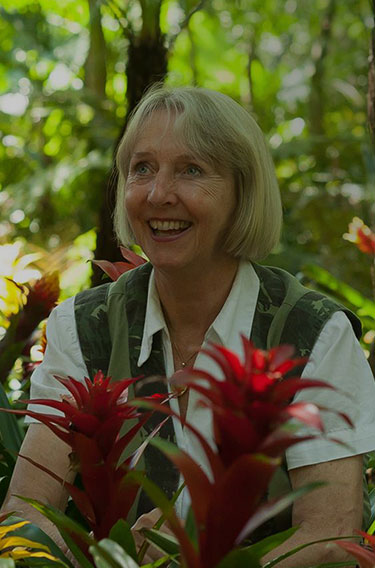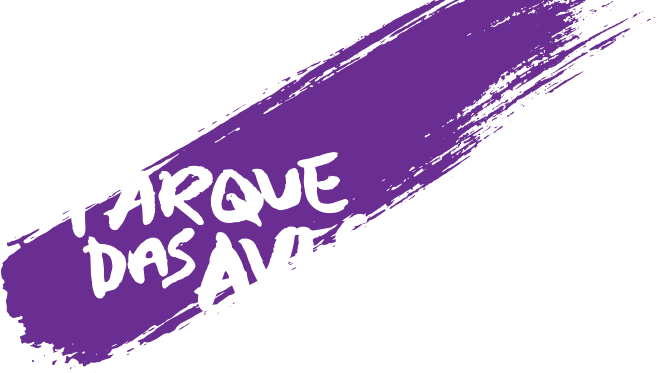

Parque das Aves works for a better world, where people can live in harmony with nature. For that, it keeps 16 hectars of Atlantic Rainforest and more than 1,300 birds, of about 130 species, more than 50% of them coming from apprehensions. Parque das Aves also participates in several species conservation programs.
Below you can learn a bit more about our story:


Parque das Aves works for a better world, where people can live in harmony with nature. For that, it keeps 16 hectars of Atlantic Rainforest and more than 1,300 birds, of about 130 species, more than 50% of them coming from apprehensions. Parque das Aves also participates in several species conservation programs.
Below you can learn a bit more about our story:
1970s
An encounter
In 1976, the veterinarian Anna-Sophie Helene moved from Germany to Namibia, Africa, where she met Dennis Croukamp. They worked together, fell in love and had two daughters: Anna-Luise and Carmel.

1980s
A passion
The couple received a Grey Parrot chick, Pumuckl, who became a family member. Other birds of the same species were brought in, and soon the family yard was filled with birds.

Early 1990s
An adventure
The family moved to the Isle of Man, in the UK. A friend suggested that they open a crocodile park in Foz do Iguaçu. Dennis replied, “I like birds. We’ll create a bird park”.

1993
A dream
With the book “Portuguese in three months” in hand, they bought 16 hectars next to the Iguaçu National Park and began building Parque das Aves in November 1993.

1993
A challenge
The couple took turns traveling between the Isle of Man and Foz do Iguaçu, taking care of their daughters and the construction of Parque das Aves, planned so that no native tree needed to be cut down. They spent all their savings on the constructions and thanks to the efforts of several people who joined the cause, the park took shape.

1994
The beginning
The first birds came from donations or loans from Brazilian zoos. They were confiscated animals sent by Ibama. Subtropical species from all continents were also imported.

1994
The Butterfly House
John Leggatt, friend of the Croukamp family, comes to Foz do Iguaçu to assist in the foundation of the Butterfly House, keeping on his work on the space to this day.

1994
An achievement
On October 7, 1994, only 11 months after Dennis and Anna had landed in Brazil, the Croukamp family inaugurated Parque das Aves.

1996
A farewell
One year after the opening of the Park, Dennis became very ill. And two years after idealizing Parque das Aves, he passed away on the Isle of Man at the age of 70. Today there is a memorial dedicated to him in his favorite place of the Park, in the River and Mangrove Birds Aviary.

1998
Using art
Plastic artist Robyn Abrey arrives in Foz do Iguaçu to draw the map at the entrance of Parque das Aves. Her love for the park is so great that in 2013 she moves to Foz to work on several other projects.

2000s
A team
Anna had to take care of the park on her own, but she was able to count on the help of incredible employees in the construction of a place that works for the conservation of several species without interfering in the forest where it is installed, enchanting thousands of tourists a year.

2000s
The recognition
Our greatest recognition is to know that abused birds find a refuge in Parque das Aves, that threatened species have the hopes of surviving renewed due to our efforts and that visitors can get to know our work, be enchanted and become part of all this.

2010s
Conservation
We work on a number of conservation projects, mainly of vulnerable and endangered species, such as the Black-fronted Piping-guan, the Red-tailed Amazon, the Vinaceous-breasted Amazon, the Alagoas Curassow and the Yellow Cardinal.

2017
Focus on the Atlantic Rainforest
During this year, after learning about the disappearance of the Purple-winged Ground-dove (Paraclaravis geoffroyi), Dr. Carmel Croukamp, Parque das Aves CEO since 2014, decided to focus the actions of the park on the conservation of species from the Atlantic Rainforest.

Your participation
Parque das Aves works to rescue seized birds and provides a welcoming environment for those that cannot return to the wild, invests in research and reproduction of species within conservation programs, in addition to educating children and training teachers with the money raised through ticket sales, in-store sales and consumption in the Gastronomic Complex, formed by Sabores da Floresta Restaurant, Bistrô da Mata and Café da Praça.

Work
Since its creation, the park has been growing thanks to a team of Brazilians dedicated to continue the dreams of Dennis Croukamp. Today Parque das Aves is the largest bird park in Latin America. “But there’s still so much to do!”, says Anna Croukamp.
Thanks for your generous contribution!

 Every day from 8:30am to 5:30pm
Every day from 8:30am to 5:30pm Prices
Prices



